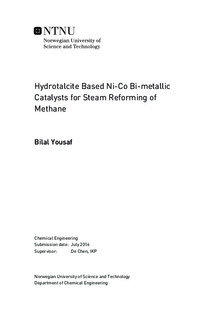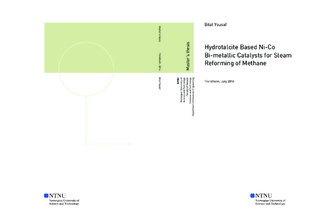| dc.description.abstract | Hydrotalcites or layered-double-hydroxides (LDH) are a class of nanostructured anionic clays. These compounds exhibit high surface areas, high thermal stability and uniform distribution of active metals. Different attempts have been made to study catalysts made from hydrotalcite like precursors for steam reforming.
The study in hand is conducted to evaluate different nickel-cobalt on hydrotalcite catalysts for the steam reforming of methane. A total of four catalysts were synthesized with a fixed nickel to cobalt ratio of 3:7, but with a total metal loading varying from 10-40 wt.%. Preparation was carried out using a co-precipitation method followed by calcination. The final hydrotalcite catalysts were then characterized using XRF, XRD, hydrogen chemisorption, nitrogen adsorption and TPR. The morphology of the catalysts was analyzed by TEM after reduction and passivation. All of the catalysts showed promising results, the formation of hydrotalcite structure was confirmed by XRD profiles. Nitrogen adsorption analysis indicated high surface areas and constant pore size, while hydrogen chemisorption showed constant dispersion and particle sizes.
The kinetic analysis of the samples was conducted in a fixed-bed reactor for the steam reforming of methane. The catalysts were analyzed for mass transfer limitations and an appropriate pellet size was selected for the analysis. It was shown that the methane conversion increased with increased in temperature. Turnover frequency analysis indicated constant activity other than for NiCo-10, while the highest rate of reaction was observed for NiCo-30 and NiCo-40. The selectivity data displayed that the water-gas-shift (WGS) was more pronounced at lower temperature, which was as expected. On the other hand, the reaction order tests indicated that the RDS depends on the methane partial pressure and that there might be a change in the reaction mechanism for NiCo-40, where it is also dependent on the hydrogen partial pressure. | |

